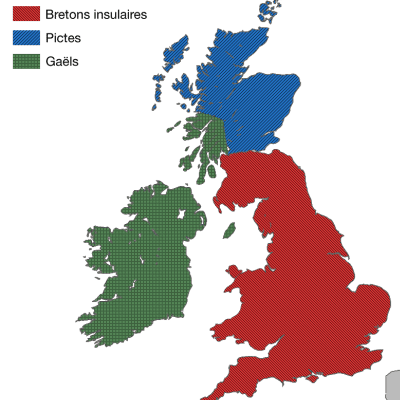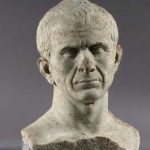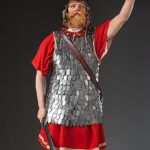Picts (picti – “painted”, the name given by the Romans because of the bodies covered in tattoos) was a group of tribes inhabiting the lands of present Scotland (north of the rivers Forth and Clyde) between the arrival of the Romans and northern Britain (around 100 CE) and the middle of the ninth century. During Roman rule, two important Pictish tribes were Verturions (Verturiones), who lived above Upper Forth and the River Earn and Caledonians. Pictish sources use the name Cruithin as a proper name. The traditional name used in Scotland is Pechs and it is now surmised that perhaps the name “Pict” is a distortion of some other word, perhaps a tribe name.
The beginnings of the Picts’ contact with the Romans should be traced to the end of the first century CE, when Julius Agricola (40-93 CE), governor in Britain, undertook an expedition around 80 AD to conquer Caledonia. Roman legions commanded by Gnaeus Julius Agricola conquered Wales from 77 to 83, and in 84 they reached almost the present Aberdee (Scotland). The historian Tacitus in the Life of Agricola reports that about 11,000 Roman cavalries and infantry, which also served the faithful to the Britons of Rome, met and fought with 30,000 Picts or Caledonians led by Galgakus (Calgakus) under Mons Graupius – an unidentified place in the Grampian mountains. The fight was fierce, according to the record 10,000 Picts died, and the Romans lost 360 soldiers. Emperor Hadrian then ordered in 122 AD to build a wall extending from the River Tyne to the Solway Firth to defend against Picts’ attacks.
Despite the efforts of the governor Agricola and the great victory of his legions in a bloody battle in the Grampian Mountains, the Roman rule never took Caledonia. However, this battle brought other far-reaching consequences. Caledonian tribes, previously numerous and for Celtic conditions very well organized practically disappeared from the arena of history. Their place was taken by older inhabitants of this mountain land – Piktowie.
Historians’ disputes regarding the origin of the Picts have lasted for a long time and there is no indication that they were to end. There are two basic concepts. The first says that the Picts were a Celtic people from the first wave of immigration to the Islands. The second wave of modern armed and better organized invaders (i.e. later Britons) drove them into the most inhospitable areas of the northern ends of today’s Scotland. The second concept tells Picts to be before the Celtic inhabitants of Britain, or rather their remains, which survived the fight against invaders and live in a difficult climate in the north.
The name “Picts” probably originated from the Latin word pictus, which means “painted”. This name was given in 297 CE by Roman soldiers. Unlike the Picts, the Romans were learned, people. Ptolemy, who lived in the 2nd century CE, made the first map of Scotland. Roman historians divided the Picts into Caledon and Verturiones. The Romans always treated the Picts with superiority and described them as dirty, backwards and performing old rituals. The Gaelic term for these people was “Cruithni” and meant “painted people,” “those who paint”.
Either way, the defeat of the Caledonian Britons allowed the Picts to spread throughout almost all of today’s Highland. We know a lot about them thanks to sources not only Roman but also Anglo-Saxon and Norman (about the exceptional vitality of the Picts society late), of course, we also owe a lot to archaeology. Unfortunately, we do not know whether it was the harsh climate and poor soil of northern Caledonia that prioritized this person, or whether it never represented a higher level of civilization. Unlike the Britons and other Celts, the Picts farmed almost no land, the basis of their economy was gathering and hunting. They also could not make the fabrics themselves, they only made clothes from an abbreviation or imported from the south. It is therefore surprising that this person reached a surprisingly high level of metallurgy, not inferior to Roman. The great, large swords made by the Picts are the direct progenitors of the Scottish two-handed swords, later famous in the Middle Ages, the Highlander’s favourite weapon. The Pict’s writing, and therefore also their entire culture, remains a mystery. We only know that the Picts community was typically matriarchal and that royal power in individual tribes, as well as supremacy over all Picts, was inherited from the female line.
The Romans did not have too much passion for the Celts, which is best demonstrated by numerous sources written with Caesar’s “Gallic War”. Cassius Dio wrote about Picts:
They can endure hunger and cold and any kind of hardship; for they plunge into the swamps and exist there for many days with only their heads above water, and in the forests they support themselves upon bark and roots, and for all emergencies they prepare a certain kind of food, the eating of a small portion of which, the size of a bean, prevents them from feeling either hunger or thirst.
– Cassius Dio, Roman history, LXXVII.12
However, it was the Picts who gave the “Sons of She-wolf” very disgusted and highly justified fear to those who had very high self-esteem. All Celts painted their bodies before the fight (plant device), but the Picts apparently had a special liking for all kinds of decorations in the form of tattoos and war colours all over the body. Hence – as some researchers say – the name of the tribe comes from. Similarly, in some other Celtic tribes, the Picts went into battle completely naked, which in combination with the mentioned paintings and large swords in their hands had to make the right impression. In addition, “painted” warriors used to stimulate themselves before the fight with drug substances (probably made from some species of fungi). They caused the warrior to lose complete control over himself and fell into a combat frenzy similar to that of the Nordic Berserkers. We know from sources that in the battle frenzy, the Picts attacked without hesitation, they did not even pay attention to the type and number of enemies, and even whether he is attacked by an enemy or a friend. They felt no pain and sometimes threw themselves at, for example, oriented spears, they fell only when too many wounds or blood loss prevented them from moving further. In the hearts of the more “civilized” warriors, they must have been terrifying. The effects of hallucinogens ended after some time, and the Pictish warriors immediately lost their frantic courage and resistance to pain, often giving way to panic. So it was a double-edged weapon.
The Picts moved perfectly in the woods and in the dark. They took steps almost inaudible to the uninitiated listener. They were also characterized by the fact that almost everyone had red hair (or black) and were tall (hence most Scots today are red).
The Picts’ invasions of Roman Britain were very bothersome – massive investments in the form of construction of Hadrian’s embankments and Antoninus testify to this best. However, Roman garrisons and fortification lines did not stop half wild robbers. They bypassed the defensive limes in a very simple but also dangerous way – by sea. The highlanders became pirates of the sea. From the decks of light boats, they attacked coastal villages and towns in search of slaves, food and goods inaccessible in Caledonia on a daily basis, such as textiles and luxury goods. These attacks, combined with the equally onerous raids of the Iraqi pirates and the increasingly insistent English, Saxons and Jutes turned Britain into a real fortress. Numerous military posts along almost the entire coast could stop only some of the attacks.
The Romans never armed either Ireland or Jutland, but the Picts were often affected by criminal legion expeditions. The conquest of Caledonia and the final elimination of the problem of Pictish attacks, however, would not pay off to the Romans. The cold and mountainous land was not very suitable for colonization and an effective economy.
The retreat of the legions from Britain finally ended in the first decade of the 5th century CE. It is believed that the Romans left Scotland around 450 CE.








